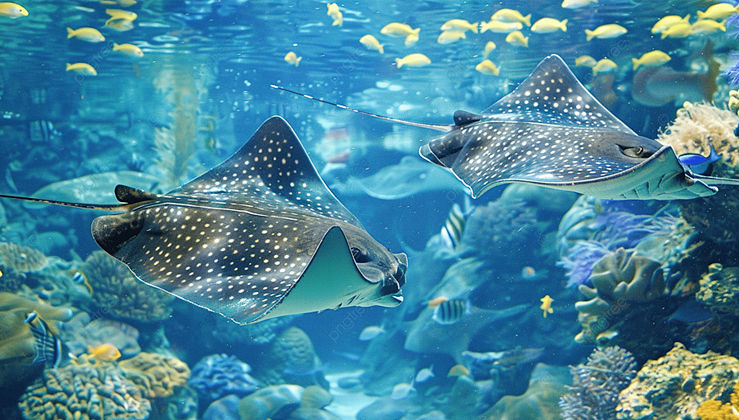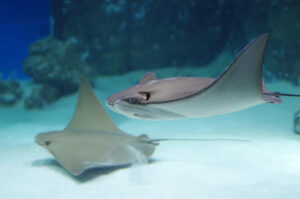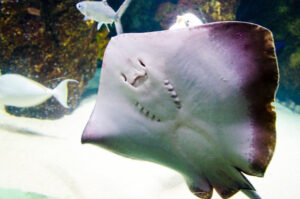15 Incredible Facts About Stingrays You Probably Didn’t Know

Discover the fascinating world of stingrays with these 15 amazing facts — from their unique movements and carnivorous diets to their ancient origins and conservation status.
1. Stingrays Are Strictly Carnivores
Stingrays are meat-eaters that prefer to dine on creatures hiding beneath the sand. A study of Caribbean stingrays revealed a diet rich in crustaceans, worms, and ray-finned fish — sometimes up to 30 prey items in a single day. In total, scientists recorded 65 different types of prey consumed by southern stingrays, showcasing their diverse appetite.
2. They ‘Fly’ Underwater by Flapping Their Fins
Stingrays appear to glide like birds beneath the sea. While many species use wave-like undulations to move, others flap their pectoral fins like wings. According to research from the Save Our Seas Foundation, stingrays in South Africa swim at speeds of around 1.35 km/h (0.83 mph) and can migrate up to 850 km (528 miles).
3. They’re Shark Relatives
Despite lacking rows of sharp teeth, stingrays are biologically close to sharks. Both belong to the cartilaginous fish group, meaning they have skeletons made of cartilage rather than bone. They also share a unique sensory system known as the ampullae of Lorenzini, which detects electric fields from potential prey.
4. Baby Stingrays Are Born Ready
Newborn stingrays, called pups, emerge fully developed and are able to swim and feed right away. They require no parental care. However, catching adult stingrays, even accidentally, can lead to premature births. In one study, 85% of blue stingrays miscarried after being captured.

5. Females Outgrow and Outlive Males
In many stingray species, females are larger and mature faster than their male counterparts. Round stingray females, for instance, reach 58% of their adult size within the first year, compared to 70% in males. However, females live significantly longer—up to 22 years—while males typically only live 5 to 7 years.
6. Touch Tank Controversy
Are stingray petting tanks ethical? The debate continues. A 2017 study by Shedd Aquarium claimed stingrays showed no signs of distress — possibly even enjoying the interaction. Yet, a year later, a tragic incident saw 34 of their 42 cownose rays die unexpectedly, raising questions about the welfare of rays in captivity.
7. They Possess Venomous Barbs
Most stingrays have one to three venomous spines on their tails. These barbs can cause intense pain, infection, and, in rare cases, fatal injuries — like the tragic death of wildlife icon Steve Irwin in 2006. The U.S. sees around 1,500–2,000 stingray stings annually, primarily on the legs or feet.
8. Stingrays Sleep Buried in Sand
To rest safely, stingrays camouflage themselves by burrowing in the sand, leaving only their eyes and venomous tail exposed. Beachgoers are advised to perform the “stingray shuffle”—dragging feet in the sand—to avoid accidentally stepping on a hidden stingray.

9. There Are Over 200 Known Species
Scientists have identified more than 220 stingray species, found across oceans and freshwater bodies. Among the rarest is the smalleye stingray, a giant species with a wingspan over 7 feet and distinctive white spots. Once extremely rare, sightings have increased off the coast of Mozambique in recent years.
10. Some Stingrays Actually Chew
Believe it or not, certain freshwater stingrays chew their food. High-speed footage from the University of Toronto showed stingrays grinding through soft fish, shrimp, and even hard-shelled dragonfly nymphs. This challenges the notion that mammals are the only chewing animals, revealing a surprising case of convergent evolution.
11. Stingrays Date Back to the Age of Dinosaurs
Fossils place stingrays at over 150 million years old, meaning they shared the planet with dinosaurs. A fossil discovered in Austria in 2019 was dated at 50 million years, adding evidence that stingrays survived the Cretaceous-Paleogene extinction event and continued evolving in Earth’s oceans.
12. Stingrays and Manta Rays Are Not the Same
Though often confused, manta rays and stingrays are different species. Manta rays lack the venomous tail stinger and live in open waters, while stingrays tend to stay closer to the ocean floor. They also differ in mouth placement: manta rays have theirs at the front, while stingrays have theirs underneath.
13. They Can Grow to Massive Sizes
The giant freshwater stingray is one of the largest freshwater fish in the world. In 2009, one was caught in Thailand measuring 14 feet and weighing up to 800 pounds. The stingray, believed to be 35–40 years old, was safely released after being measured.
14. They Sense Earth’s Magnetic Field
In a 2020 study, yellow stingrays were found to navigate using Earth’s magnetic field. The experiment showed that stingrays could detect geomagnetic changes and orient themselves accordingly — a natural GPS system for the seas.
15. Over Two Dozen Species Are Endangered
According to the IUCN, at least 26 stingray species are classified as Endangered or Critically Endangered. One of them, the roughnose cowtail ray, has suffered a population drop of up to 79% due to overfishing and habitat loss, reflecting the growing threats stingrays face in the wild.

Help Protect Stingrays
-Shuffle your feet in shallow waters to alert nearby stingrays and avoid accidental stings.
-Support sustainable seafood choices and oppose overfishing by checking fish guides like FishWatch.gov.
-Participate in beach cleanups or join conservation organizations like Ocean Conservancy.
-Treat wildlife with respect. Observe stingrays from a distance and never attempt to touch or chase them in the wild.





